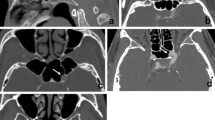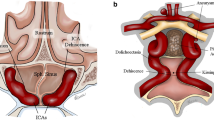Abstract
Purpose
Although cerebrovascular mortality is increased up to eightfold in acromegaly, intracranial internal carotid artery (ICA) changes have not been well investigated. This is a magnetic resonance angiography (MRA) quantitative cross-sectional study of ICA tortuosity, ectasia and intercarotid distance in acromegalic patients with subsequent analysis of concomitant clinical, laboratory and neuroimaging findings.
Methods
One hundred seventy six acromegalic patients (mean-age 55 ± 14 years, age range 21–88, 92 females) and 104 subjects with headache or transient neurological deficits underwent MRA with the same 1.5 T scanner. Clinical data, laboratory and pituitary adenoma imaging findings were recorded. Using a commercially available software, we measured the tortuosity index [(curved/linear ICA length from C3-midpoint to intracranial bifurcation) − 1], ICA ectasia index (intracavernous/petrous ICA diameter) and intercarotid distance at C3 and C4 levels.
Results
Mean ICA tortuosity and ectasia indices were increased in acromegalic patients compared with controls (1.06 ± 0.29 vs 0.93 ± 0.26, p < 0.001; 1.02 ± 0.10 vs 0.92 ± 0.09, p < 0.001). Mean intercarotid distance was reduced at C3 and increased at C4 in acromegalic patients (16.7 ± 3.4 vs 17.9 ± 2.5 mm, p < 0.001; 16.7 ± 4.6 vs 15.4 ± 4.1 mm, p < 0.05; t test). ICA tortuosity and ectasia correlated neither with laboratory findings nor with previous or current treatment. On multivariate analysis, C3 intercarotid distance was reduced in patients on dopamine agonist treatment (p < 0.01) and increased in patients with GH-deficit (p = 0.01), while C4 intercarotid distance was increased with macroadenoma (p = 0.01) and reduced in patients under dopamine agonist (p < 0.01) or somatostatin analogue (p < 0.05) treatment.
Conclusions
Intracranial ICA changes are common findings in acromegaly, and further studies focused on their possible clinical impact are needed.


Similar content being viewed by others
References
Jayasena CN, Comninos AN, Clarke H, Donaldson M, Meeran K, Dhillo WS (2011) The effects of long-term growth hormone and insulin-like growth factor-1 exposure on the development of cardiovascular, cerebrovascular and metabolic co-morbidities in treated patients with acromegaly. Clin Endocrinol 75:220–225
Erfurth EM, Hagmar L (2005) Cerebrovascular disease in patients with pituitary tumors. Trends Endocrinol Metab 16:334–342
Oshino S, Nishino A, Suzuki T, Arita H, Tateishi A, Matsumoto K, Shimokawa T, Kinoshita M, Yoshimine T, Saitoh Y (2013) Prevalence of cerebral aneurysm in patients with acromegaly. Pituitary 16:195–201
Manara R, Maffei P, Citton V, Rizzati S, Bommarito G, Ermani M, Albano I, Della Puppa A, Carollo C, Pavesi G, Scanarini M, Ceccato F, Sicolo N, Mantero F, Scaroni C, Martini C (2011) Increased rate of intracranial saccular aneurysms in acromegaly: an MR angiography study and review of the literature. J Clin Endocrinol Metab 96:1292–1300
Silha JV, Krsek M, Hana V, Marek J, Weiss V, Jezkova J, Rosicka M, Jarkovska Z, Murphy LJ (2005) The effects of growth hormone status on circulating levels of vascular growth factors. Clin Endocrinol 63:79–86
Dassie F, Grillo A, Carretta R, Fabris B, Macaluso L, Bardelli M, Martini C, Paoletta A, Vettor R, Sicolo N, Fallo F, Maffei P (2012) Ambulatory arterial stiffness indexes in acromegaly. Eur J Endocrinol 166:199–205
Paisley AN, Banerjee M, Rezai M, Schofield RE, Balakrishnannair S, Herbert A, Lawrance JA, Trainer PJ, Cruickshank JK (2011) Changes in arterial stiffness but not carotid intimal thickness in acromegaly. J Clin Endocrinol Metab 96:1486–1492
Rizzoni D, Porteri E, Giustina A, De Ciuceis C, Sleiman I, Boari GE, Castellano M, Muiesan ML, Bonadonna S, Burattin A, Cerudelli B, Agabiti-Rosei E (2004) Acromegalic patients show the presence of hypertrophic remodeling of subcutaneous small resistance arteries. Hypertension 43:561–565
Schiavon F, Maffei P, Martini C, De Carlo E, Fais C, Todesco S, Sicolo N (1999) Morphologic study of microcirculation in acromegaly by capillaroscopy. J Clin Endocrinol Metab 84:3151–3155
Maison P, Démolis P, Young J, Schaison G, Giudicelli JF, Chanson P (2000) Vascular reactivity in acromegalic patients: preliminary evidence for regional endothelial dysfunction and increased sympathetic vasoconstriction. Clin Endocrinol 53:445–451
Saffer D, Segal F, Faerber EN, Jackson S (1974) Acromegaly presenting with hemiplegia. S Afr Med J 48:684–686
Warembourg H, Niquet G, Merlen JF, Ducloux G, Dubeaux PA (1963) Dolichomegaarteries. Lille Med 41:661–668
Hatam A, Greitz T (1972) Ectasia of cerebral arteries in acromegaly. Acta Radiol Diagn 12:410–418
Sacher M, Som PM, Shugar JM, Leeds NE (1986) Kissing intrasellar carotid arteries in acromegaly: CT demonstration. J Comput Assist Tomogr 10:1033–1035
Morris SA, Orbach DB, Geva T, Singh MN, Gauvreau K, Lacro RV (2011) Increased vertebral artery tortuosity index is associated with adverse outcomes in children and young adults with connective tissue disorders. Circulation 124:388–396
Pico F, Labreuche J, Seilhean D, Duyckaerts C, Hauw JJ, Amarenco P (2007) Association of small-vessel disease with dilatative arteriopathy of the brain: neuropathologic evidence. Stroke 38:1197–1202
Pico F, Labreuche J, Touboul PJ, Amarenco P (2003) GENIC investigators: intracranial arterial dolichoectasia and its relation with atherosclerosis and stroke subtype. Neurology 61:1736–1742
Ebner FH, Kuerschner V, Dietz K, Bueltmann E, Naegele T, Honegger J (2009) Reduced intercarotid artery distance in acromegaly: pathophysiologic considerations and implications for transsphenoidal surgery. Surg Neurol 72:456–460
Wilson CB (1997) Surgical management of pituitary tumors. J Clin Endocrinol Metab 82:2381–2385
Laws ER (1999) Vascular complications of transphenoidal surgery. Pituitary 2:163–170
Melmed S (2006) Medical progress: acromegaly. N Engl JMed 355:2558–2573
Vieira JO Jr, Cukiert A, Liberman B (2006) Evaluation of magnetic resonance imaging criteria for cavernous sinus invasion in patients with pituitary adenomas: logistic regression analysis and correlation with surgical findings. Surg Neurol 65:130–135
Maffei P, Albano I, Martini C, Barban M, Manara R, Meneghetti G, Sicolo N (2009) Middle cerebral artery occlusion 25 years after cranial radiation therapy in acromegaly: a case report. J Thromb Thrombolysis 28:358–361
Manara R, Bommarito G, Rizzati S, Briani C, Puppa AD, Citton V, Zanchetta E, Zerbo F, Ermani M, Martini C, Mantero F, Sicolo N, Maffei P, Scaroni C (2012) Herniation of cerebellar tonsils in acromegaly: prevalence, pathogenesis and clinical impact. Pituitary 16:122–130
Bouthillier A, van Loveren HR, Keller JT (1996) Segments of the internal carotid artery: a new classification. Neurosurgery 38:425–432
Holdaway IM (2007) Excess mortality in acromegaly. Hormone Res 68:166–172
Morris SA, Orbach DB, Geva T, Singh MN, Gauvreau K, Lacro RV (2011) Increased vertebral artery tortuosity index is associated with adverse outcomes in children and young adults with connective tissue disorders. Circulation 124:388–396
Lincoln DT, Singal PK, Al-Banaw A (2007) Growth hormone in vascular pathology: neovascularization and expression of receptors is associated with cellular proliferation. Anticancer Res 27:4201–4218
Acqui M, Ferrante L, Matronardi L, d’Addetta R (1988) Alteration of the collagen type III/type I ratio and intracranial saccular aneurysms in GH-secreting hypophyseal adenomas. Ital J Neurol Sci 9:365–368
Shigemori M, Shirahama M, Hara K, Tokutomi T, Kawaba T (1982) Traumatic aneurysms of intracranial internal carotid arteries case reports. Neurol Med Chir 22:241–247
Onishi H, Ito H, Kuroda E, Yamamoto S, Kubota T (1989) Intracranial mycotic aneurysm associated with transsphenoidal surgery to the pituitary adenoma. Surg Neurol 31:149–154
Sutton LN, Gusnard D, Bruce DA, Fried A, Packer RJ, Zimmerman RA (1991) Fusiform dilatations of the carotid artery following radical surgery of childhood craniopharyngiomas. J Neurosurg 74:695–700
Pereira P, Cerejo A, Cruz J, Vaz R (2002) Intracranial aneurysm and vasculopathy after surgery and radiation therapy for craniopharyngioma: case report. Neurosurgery 50:885–888
Mangiardi JR, Aleksic SN, Lifshitz M, Pinto R, Budzilovic GN, Pearson J (1983) Coincidental pituitary adenoma and cerebral aneurysm with pathological findings. Surg Neurol 19:38–41
Fukuda I, Hizuka N, Murakami Y, Itoh E, Yasumoto K, Sata A, Takano K (2001) Clinical features and therapeutic outcomes of 65 patients with acromegaly at Tokyo women’s medical university. Inter Med 40:987–992
Lotinun S, Limlomwongse L, Sirikulchayanonta V, Krishnamra N (2003) Bone calcium turnover, formation, and resorption in bromocriptine- and prolactin-treated lactating rats. Endocrine 20:163–170
Conflict of interest
None.
Author information
Authors and Affiliations
Corresponding author
Additional information
Renzo Manara and Joseph Gabrieli have equally contributed to the manuscript and should be considered first coauthors.
Chiara Martini and Pietro Maffei should be considered co-senior authors.
Electronic supplementary material
Below is the link to the electronic supplementary material.
Rights and permissions
About this article
Cite this article
Manara, R., Gabrieli, J., Citton, V. et al. Intracranial internal carotid artery changes in acromegaly: a quantitative magnetic resonance angiography study. Pituitary 17, 414–422 (2014). https://doi.org/10.1007/s11102-013-0516-y
Published:
Issue Date:
DOI: https://doi.org/10.1007/s11102-013-0516-y




